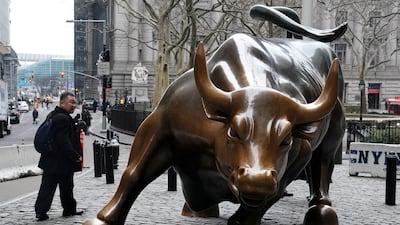The US economy grew at a faster-than-expected pace in the third quarter, showing that consumers so far have largely been undaunted by higher interest rates although underlying numbers suggest momentum could be slowing down.
Gross domestic product advanced 5.2 per cent, a revision from 4.9 per cent, according to a report from the Commerce Department.
Strong economic growth followed second-quarter increase of 2.1 per cent.
The new figure reflected upwards revisions in businesses buying machinery, and state and local government spending.
Meanwhile, consumer spending, which accounts for 70 per cent of US economic activity, was revised downwards from 4.0 per cent to 3.6 per cent.
But economists expect the US's bumper third quarter will not last, and a separate report from the Federal Reserve on Wednesday hinted that economic growth in the fourth quarter may not be as strong.
"On balance, economic activity slowed since the previous report," the Fed reported in its Beige Book on economic conditions for November.
US consumers showed "more price sensitivity" last month as sales on discretionary items such as furniture and appliances declined last month, the Fed reported.
Demand for labour continued to ease although several Federal Reserve districts described jobs markets as "tight".
Overall, Wednesday's reports add to growing hopes that the Fed can achieve a soft landing.
By raising interest rates to a 22-year high, the Fed hopes that it can moderate inflation without driving the economy into a recession.
Recent economic reports strengthen this confidence. Consumer Price Index inflation has fallen to 3.2 per cent, far lower than the 9.1 per cent last summer.
The Personal Consumption Expenditures Price Index was revised downwards to 2.8 per cent.
Fed officials projected the economy to expand by a range of 1.9 to 2.2 per cent this year, according to its September projections.
COMPANY%20PROFILE
%3Cp%3E%3Cstrong%3EName%3A%20%3C%2Fstrong%3EQureos%0D%3Cbr%3E%3Cstrong%3EBased%3A%20%3C%2Fstrong%3EUAE%0D%3Cbr%3E%3Cstrong%3ELaunch%20year%3A%20%3C%2Fstrong%3E2021%0D%3Cbr%3E%3Cstrong%3ENumber%20of%20employees%3A%20%3C%2Fstrong%3E33%0D%3Cbr%3E%3Cstrong%3ESector%3A%20%3C%2Fstrong%3ESoftware%20and%20technology%0D%3Cbr%3E%3Cstrong%3EFunding%3A%20%3C%2Fstrong%3E%243%20million%0D%3Cbr%3E%3C%2Fp%3E%0A
UAE currency: the story behind the money in your pockets
Living in...
This article is part of a guide on where to live in the UAE. Our reporters will profile some of the country’s most desirable districts, provide an estimate of rental prices and introduce you to some of the residents who call each area home.
UPI facts
More than 2.2 million Indian tourists arrived in UAE in 2023
More than 3.5 million Indians reside in UAE
Indian tourists can make purchases in UAE using rupee accounts in India through QR-code-based UPI real-time payment systems
Indian residents in UAE can use their non-resident NRO and NRE accounts held in Indian banks linked to a UAE mobile number for UPI transactions
The biog
Age: 46
Number of Children: Four
Hobby: Reading history books
Loves: Sports
The specs
Price, base: Dh228,000 / Dh232,000 (est)
Engine: 5.7-litre Hemi V8
Transmission: Eight-speed automatic
Power: 395hp @ 5,600rpm
Torque: 552Nm
Fuel economy, combined: 12.5L / 100km
Veil (Object Lessons)
Rafia Zakaria
Bloomsbury Academic
KILLING OF QASSEM SULEIMANI
The low down
Producers: Uniglobe Entertainment & Vision Films
Director: Namrata Singh Gujral
Cast: Rajkummar Rao, Nargis Fakhri, Bo Derek, Candy Clark
Rating: 2/5
Killing of Qassem Suleimani
Killing of Qassem Suleimani
Red Joan
Director: Trevor Nunn
Starring: Judi Dench, Sophie Cookson, Tereza Srbova
Rating: 3/5 stars
Scoreline
Abu Dhabi Harlequins 17
Jebel Ali Dragons 20
Harlequins Tries: Kinivilliame, Stevenson; Cons: Stevenson 2; Pen: Stevenson
Dragons Tries: Naisau, Fourie; Cons: Love 2; Pens: Love 2
Representing%20UAE%20overseas
%3Cp%3E%0DIf%20Catherine%20Richards%20debuts%20for%20Wales%20in%20the%20Six%20Nations%2C%20she%20will%20be%20the%20latest%20to%20have%20made%20it%20from%20the%20UAE%20to%20the%20top%20tier%20of%20the%20international%20game%20in%20the%20oval%20ball%20codes.%0D%3Cbr%3E%20%0D%3Cbr%3E%3Cstrong%3ESeren%20Gough-Walters%20(Wales%20rugby%20league)%3C%2Fstrong%3E%0D%3Cbr%3EBorn%20in%20Dubai%2C%20raised%20in%20Sharjah%2C%20and%20once%20an%20immigration%20officer%20at%20the%20British%20Embassy%20in%20Abu%20Dhabi%2C%20she%20debuted%20for%20Wales%20in%20rugby%20league%20in%202021.%0D%3Cbr%3E%20%0D%3Cbr%3E%3Cstrong%3ESophie%20Shams%20(England%20sevens)%3C%2Fstrong%3E%0D%3Cbr%3EWith%20an%20Emirati%20father%20and%20English%20mother%2C%20Shams%20excelled%20at%20rugby%20at%20school%20in%20Dubai%2C%20and%20went%20on%20to%20represent%20England%20on%20the%20sevens%20circuit.%20%0D%3Cbr%3E%20%0D%3Cbr%3E%3Cstrong%3EFiona%20Reidy%20(Ireland)%3C%2Fstrong%3E%0D%3Cbr%3EMade%20her%20Test%20rugby%20bow%20for%20Ireland%20against%20England%20in%202015%2C%20having%20played%20for%20four%20years%20in%20the%20capital%20with%20Abu%20Dhabi%20Harlequins%20previously.%0D%3C%2Fp%3E%0A
INFO
What: DP World Tour Championship
When: November 21-24
Where: Jumeirah Golf Estates, Dubai
Tickets: www.ticketmaster.ae.
World%20Food%20Day%20
%3Cp%3ECelebrated%20on%20October%2016%2C%20to%20coincide%20with%20the%20founding%20date%20of%20the%20United%20Nations%20Food%20and%20Agriculture%20Organisation%2C%20World%20Food%20Day%20aims%20to%20tackle%20issues%20such%20as%20hunger%2C%20food%20security%2C%20food%20waste%20and%20the%20environmental%20impact%20of%20food%20production.%20%0D%3C%2Fp%3E%0A
Ukraine
Capital: Kiev
Population: 44.13 million
Armed conflict in Donbass
Russia-backed fighters control territory
COMPANY%20PROFILE
%3Cp%3E%3Cstrong%3EName%3A%20%3C%2Fstrong%3EKinetic%207%3Cbr%3E%3Cstrong%3EStarted%3A%3C%2Fstrong%3E%202018%3Cbr%3E%3Cstrong%3EFounder%3A%3C%2Fstrong%3E%20Rick%20Parish%3Cbr%3E%3Cstrong%3EBased%3A%3C%2Fstrong%3E%20Abu%20Dhabi%2C%20UAE%3Cbr%3E%3Cstrong%3EIndustry%3A%3C%2Fstrong%3E%20Clean%20cooking%3Cbr%3E%3Cstrong%3EFunding%3A%3C%2Fstrong%3E%20%2410%20million%3Cbr%3E%3Cstrong%3EInvestors%3A%3C%2Fstrong%3E%20Self-funded%3C%2Fp%3E%0A


